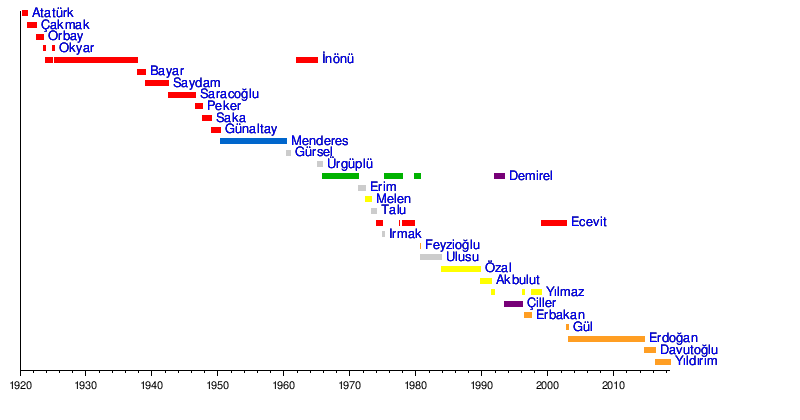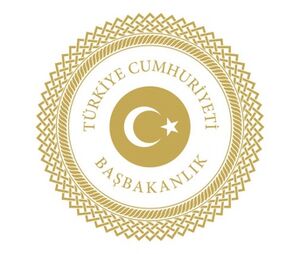Prime Minister of Turkey facts for kids
Quick facts for kids Prime Minister ofthe Republic of Turkey |
|
|---|---|
| Executive branch of the Turkish Government | |
| Member of | Cabinet of Turkey National Security Council |
| Reports to | The Parliament |
| Residence | Prime Ministry Building (1925–1937) Başbakanlık Konutu (1937–2014) Çankaya Mansion (2014–2018) |
| Appointer | The president
In accordance with voting in the Grand National Assembly
|
| Term length | 5 years (same as the term of Grand National Assembly)
While commanding the majority in the parliament. No term limits are imposed on the office.
|
| Constituting instrument | Constitution of Turkey |
| Precursor | Grand Vizier of the Ottoman Empire |
| Formation | 3 May 1920 (Ankara Government) 1 November 1923 (Republic) |
| First holder | Mustafa Kemal Atatürk (Ankara Government) İsmet İnönü (Republic) |
| Final holder | Binali Yıldırım |
| Abolished | 9 July 2018 |
| Deputy | Deputy Prime Minister |
The Prime Minister of Turkey was a very important leader in the Republic of Turkey. This role existed from 1920 until 2018. The Prime Minister was the head of government, meaning they led the country's main political team.
They worked with the Turkish Parliament and was in charge of the cabinet, which is a group of top government officials. Over time, the Prime Minister's duties and powers changed. Before the role was ended in 2018, the Prime Minister was usually the most powerful person in Turkish politics, even more so than the President.
Contents
History of Turkey's Prime Ministers
Ottoman Empire Era
In the old Ottoman Empire, the leader similar to a Prime Minister was called the Grand Vizier. This person was the main advisor to the Ottoman sultan. In the 1800s, some leaders were even called "Prime Minister" (Başnazır).
Later, the Grand Viziers started to lead cabinets, which are groups of ministers. After a period of reforms called the Tanzimat, Grand Viziers became more like the Prime Ministers in European countries. A parliament was created to watch over the Grand Vizier. Eventually, the Grand Vizier became responsible to the parliament, not just the Sultan.
Early Turkish Government
After the Turkish National Movement created the Grand National Assembly in Ankara, they set up a new government. This government was called "The Cabinet of the Executive Ministers." The person in charge of this cabinet was the Speaker of the Parliament.
Modern Republic of Turkey
One-Party Period (1923–1945)
When Turkey became a republic, the rules were changed. The Prime Minister was given the power to run the government. The President of Turkey would choose the Prime Minister.
Even though the President's job was mostly symbolic, early Presidents like Atatürk and İnönü were very powerful. They were also the leaders of their political party, the Republican People's Party.
Multi-Party Period (1945–2018)
Before the 1950 elections, new rules were made. The President could no longer be the leader of a political party. This change made the Prime Minister the most important person in Turkish politics. The President's role became less powerful.
After a military takeover in 1960, a new set of rules was made in 1961. These rules reduced the government's power and gave more control to the parliament. This led to many short-lived governments, as different parties had to work together.
In 1982, after another military takeover, a new set of rules was put in place. These rules aimed to create more stable governments. They included a rule that a party needed at least 10% of the votes to get seats in parliament. The Prime Minister's powers were also made very strong. Ministers were directly supervised by the Prime Minister.
Over the years, many changes were made to these rules. Some of the most important changes happened in 2007, 2010, and 2017. These changes were voted on by the public and some were quite debated.
In 2014, the President was directly elected by the people for the first time. Some people thought this made Turkey's system more like a "semi-presidential system." This meant the President started to have more power, and the Prime Minister's dominant role began to lessen.
Finally, after the 2018 general elections, the changes from the 2017 vote officially took effect. This marked the end of the Prime Minister's role and nearly 100 years of parliamentary government in Turkey.
Timeline of Prime Ministers

See also
 In Spanish: Primer ministro de Turquía para niños
In Spanish: Primer ministro de Turquía para niños



